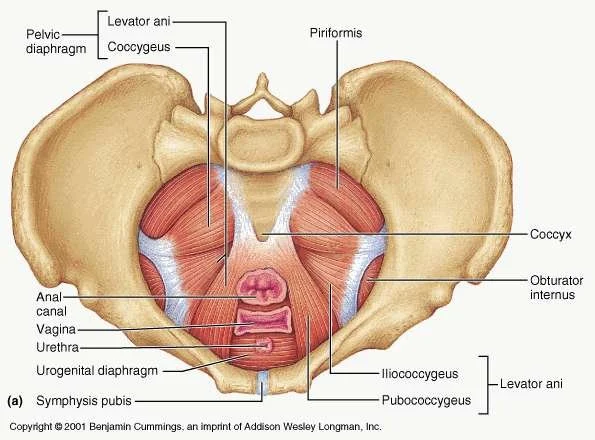The “latent” period of postpartum recovery occurs from 6 weeks to 6 months after delivery but full postpartum recovery takes up to 2 years (that we are aware of in 2025). By that time, your hair should stop falling out. You should no longer have physical symptoms (like bladder leakage or Diastasis Recti). Your period may come back around the 6 month mark, but it could take up to 2 years for your hormones to re-balance. If you’ve had a C-section, you may feel more tired at the 6 month mark than those who had a vaginal delivery. Mentally, you may be getting more into a routine as your baby is sleeping more. Though, of course, it is important to address any lingering mental health concerns.
Bladder Prolapse
Cystocele (SIS-toe-seel) is when the bladder drops from its usual position and presses on the vaginal wall. A type of pelvic organ prolapse, cystocele or anterior vaginal prolapse, can occur if the pelvic floor muscles are weak, the organ is not in the correct spot in the pelvis in general (especially post child birth) or if there is too much pressure put on the pelvic floor. Common causes of a prolapsed bladder include repetitive stress over time (e.g., coughing, improper lifting) or during vaginal childbirth.
3rd Trimester Fun!
The final trimester is all about growth and preparation – for you and baby! This can be another physically and emotionally challenging time as you prepare for birth; balance feelings like excitement, fatigue, and worry; and experience physical discomfort as the baby grows. This is also generally the time that you take lactation and birth prep classes.
Breath Work
Sometimes we just need to take a deep breath for a moment when life becomes too stressful or chaotic or overwhelming. But have you ever noticed how you take that deep breath?
Here at Recharged PT, we’ve talked *a lot* before about the importance of appropriate core engagement for pelvic health. This includes learning how to breathe properly. So today we are going back to the basics to learn how to breathe.
Pelvic Floor Physical Therapy Melbourne FL, Dr. Paige, Dr. Laura, Pelvic Rehab
Kegels
There is a reason that Kegels are considered the classic pelvic floor exercise. They are very effective for a lot of pelvic floor issues — when done correctly for the right type of dysfunction. So before you start doing them, make sure they are the right exercises for you by chatting with a pelvic floor PT first.
Obturator Internus Pelvic Floor Pain
The Obturator Internus (OI) is a muscle that sits deep in the hip girdle, running from the front of the pubic bones and inserting onto the greater trochanter (the top bony part of the thigh bone). The OI is a deep hip stabilizer, which means it helps stabilize the head of the femur (thigh bone) to keep it in socket. This muscle is also responsible for external rotation – or rolling out– of the hip and thigh. Additionally, the OI shares a fascial connection to most, if not all, of the deep pelvic floor muscles. People with dysfunction of the Obturator Internus often complete of a deep groin, hip or back pain that won’t go away with regular stretching.
Pelvic Health, Pelvic Floor Rehab, Pelvic Floor Exercises, Pelvic Pain, Pain with Intercourse, Melbourne, FL, Postpartum, Postpartum Rehab, Pee Leakage, Dr. Paige, Dr. Laura, Recharged Performance Therapy
Urge Incontinence
Urge incontinence occurs when you have a sudden desire to go to the bathroom due a very quick and powerful bladder contraction. This is sometimes followed by the involuntary loss of urine before you can make it to a toilet. Urge incontinence (UI) is characterized by the need to go often throughout the day – especially at night (nocturia) – with small amounts of urine actually released. “Frequent” means more than 8x during the day and >2 at night. Enuresis (bed wetting) may also occur.
Pelvic Health, Pelvic Floor Rehab, Pelvic Floor Exercises, Urge Incontinence, Melbourne, FL, Postpartum, Postpartum Rehab, Pee Leakage, Dr. Paige, Dr. Laura, Recharged Performance Therapy
Dribbling After You Pee
Overflow Incontinence occurs when your bladder doesn’t completely empty when you go to the bathroom. You may or may feel the urge *to go* with this type of incontinence. But it is very common for only small amounts of urine to be released throughout the day as your bladder refills- which means you go to the bathroom all the time because you aren’t really emptying.
Doooowwwnn, Bessy!
Here are 3 AMAZING ways to help your pelvic floor stay relaxed and amazingly strong… and guess what! They have NOTHING to do with Kegels!!
We don’t have to live with a tight pelvic floor. There are some simple, practical habits you can incorporate into your daily routine to help loosen everything up. If these tips don’t feel like enough, going to a pelvic floor physical therapist to evaluate your specific needs might help!
Pelvic Floor Rehabilitation, Pelvic Floor PT, Pee Leakage, Urinary Frequency, Incontinence, Dr. Paige, Recharged Performance Therapy, Health, Hormones, women’s health











